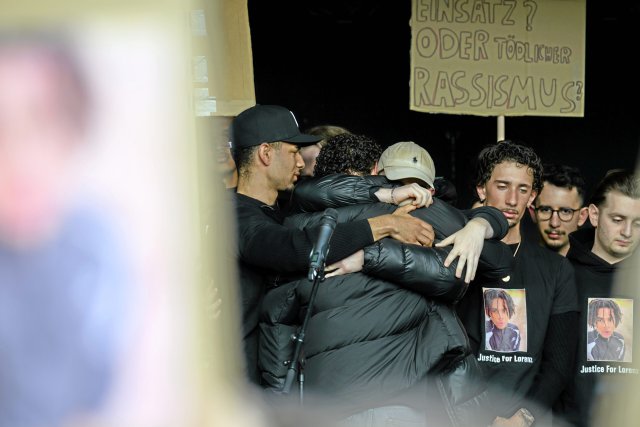Deadly police violence | Fatal shooting of Lorenz A. discussed in state parliament
The fatal police operation against 21-year-old Lorenz A. in Oldenburg is now officially a matter for state politics. On Thursday, the Lower Saxony State Parliament discussed the case and the findings to date in a special session of the Committee on the Interior. This can only be a first step toward a political investigation into what happened – much remains open, much unanswered.
According to current investigations, five shots were fired from the service weapon of a 27-year-old police officer on Easter night. At least three projectiles hit the fleeing Lorenz A. from behind – in the head, upper body, and hip. A fourth shot grazed his thigh; a fifth missed. These autopsy findings shocked many. SPD interior politician Saade emphasized to the committee: "When shots hit from behind, these are serious questions."
The state government felt compelled to demonstrate transparency early on. Within a little over two weeks, at the initiative of the CDU parliamentary group, the case was on the agenda. The meeting took place in the state parliament's large forum, with numerous spectators following the briefing – many from Hanover, some traveling especially from Oldenburg. The atmosphere was tense, focused – and at times even angry.
State Police President Axel Brockmann described the course of events as reconstructed by the investigation so far: Lorenz A. was turned away from a nightclub, which led to an altercation. A. threw a glass and sprayed pepper spray, then fled. When pursuers tried to arrest him, he held them at bay with a knife. Several emergency calls followed. The first patrol arrived in the area shortly thereafter but was unable to apprehend A. The fatal encounter ultimately occurred on Achternstraße.
"It was a high-stress situation," Brockmann emphasized several times in the committee – a term that became key to interpreting the events. Today, it seems important to him to add a new nuance to the role of the knife: After initially falsely claiming that A. had directly threatened the officers, the previous radio warning about the knife is now coming into focus. The shooter's patrol partner, as reported to the committee, now claims that the 21-year-old reached into his jacket pocket and did not stop despite loud requests. He ran past the driver's side of the car – at that moment the shots were fired. Both men fell to the ground. Pepper spray was confiscated next to Lorenz A., who was pronounced dead shortly afterwards; the police officer was taken to the hospital with eye irritation.

Bockmann was unable or unwilling to explain why A. was hit from behind. Video recordings – one of which includes audio – are currently being analyzed by the State Criminal Police Office. Bodycam footage is not available. Gunshot residue, the angle of the shot, and ballistics reports should now provide further information. The police officer's cell phone has also been confiscated. He is being investigated for manslaughter. However, Brockmann clarified one point in the committee: "Contrary to numerous reports, the officer has not been suspended." He is currently unfit for duty and is receiving psychological counseling – the well-being of the officer was discussed more intensively in the committee than that of his relatives, viewers later warned "nd."
According to the Ministry of Justice, there was "no evidence of racist motivation" – a statement that raised questions among viewers: What even counts as such an "indication"? Where is the line drawn between individual motivation and structural racism? A definition was not provided in the committee or subsequently upon request outside the State Parliament Forum.
Shortly after the death, protests formed in Oldenburg and other cities. Ten "actions under the law on assembly" were reported to the committee. Many see parallels to previous cases of fatal police violence against Black or otherwise marginalized people. In personal conversations after the meeting, names were mentioned – Lamin Touray, Qosay Khalaf – and questions were raised about patterns and responsibility. Both names represent similar cases in Lower Saxony, but were not mentioned in the official committee meeting. Green Party politician Diallo-Hartmann summed it up in the committee: "You have to look closely at which people are affected by police violence." A systematic recording of racist discrimination is lacking to date.
The Justice for Lorenz initiative is therefore calling for an independent investigation. However, the Delmenhorst police station – part of the same directorate as the Oldenburg precinct – is responsible. While Lorenz A. was buried in a small ceremony in Oldenburg almost simultaneously with the committee meeting, there will be another demonstration for him on Sunday: Starting at 2 p.m., his 22nd birthday will be celebrated – in reality, re-dedicated to a memorial.
The nd.Genossenschaft belongs to our readers and authors. Through the cooperative, we guarantee the independence of our editorial team and strive to make our texts accessible to everyone—even if they don't have the money to help finance our work.
We don't have a hard paywall on our website out of conviction. However, this also means that we have to repeatedly ask everyone who can contribute to help finance our journalism. This is stressful, not only for our readers, but also for our authors, and sometimes it becomes too much.
Nevertheless: Only together can we defend left-wing positions!
With your support we can continue to:→ Provide independent and critical reporting. → Cover issues overlooked elsewhere. → Create a platform for diverse and marginalized voices. → Speak out against misinformation and hate speech.
→ Accompany and deepen social debates from the left.
nd-aktuell


